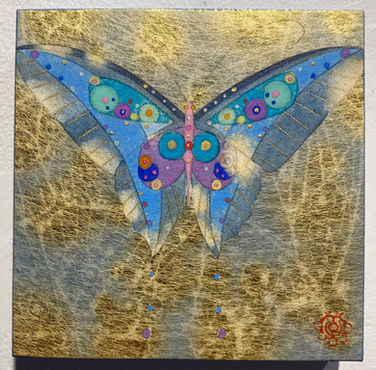

Toyohiko Nishijima
About
Toyohiko Nishijima is a visionary artist whose work embodies the evolution of his personal philosophy and the spiritual and artistic endeavors of each phase of his life. As Nishijima eloquently puts it, "We ourselves keep on changing, and that shows that we are alive." This profound sentiment underscores his artistic journey, which we showcase here through a retrospective of his works.
Nishijima's artistic approach is characterized by a unique fusion of three traditional Japanese techniques: paper-making, lacquer painting (urushi), and nihonga (Japanese-style painting). His mastery of these crafts has enabled him to develop a distinctive artistic style that captivates and resonates with viewers.
In his paper-making (washi) technique, Nishijima takes great pride in producing 100% handmade washi from plants he cultivates himself. From growing the pulp plants to processing them into paper, he meticulously crafts washi with a refined traditional technique, achieving an extraordinary thinness (as minimal as 0.03 mm) and glossy texture. This exceptional washi-making method allows him to create detailed and subtle watermark drawings during the paper-forming process.
Nishijima's exploration of lacquer (urushi), an ancient Japanese coating practice dating back 9000 years, showcases his dedication to craftsmanship and precision. He meticulously applies multiple layers of urushi, followed by a labor-intensive process of polishing, resulting in a deep, beautiful black finish with a sophisticated gloss. This process, deeply influenced by the dialogue with nature and the effects of humidity on lacquer hardening, embodies his commitment to time-honored techniques and artistic dialogue with the environment.
As a seasoned Japanese painter with over twenty years of experience, Nishijima's expertise in traditional Japanese painting shines through in his use of natural pigments on washi. This technique, utilizing pigments derived from plants, animals, or minerals mixed with glue, exemplifies the rich history and enduring popularity of Japanese painting. Nishijima's works in this medium are a testament to his deep-rooted connection to Japan's artistic heritage.
Through his innovative integration of paper-making, lacquer, and Japanese painting, Toyohiko Nishijima invites us into a world where artistry and philosophy converge. His works resonate with a profound sense of vitality and transformation, echoing the sentiment that art, like life itself, is a dynamic and ever-evolving expression of the human experience.

HIGHLIGHTS
The God of Thunder and Wind
2025, Diptych, original semiconductor base, Washi paper, gold, pigment paintings on wooden panel
35 x 35 cm each panel.
A remarkable futuristic work by Japanese artist Toyohiko Nishijima, Raijin Fujin (The God of Thunder and Wind) pays homage to Tawaraya Sōtatsu’s iconic 17th-century folding screen. Rather than replicating the original, Nishijima reimagines these divine forces of wind and thunder through the symbolic aesthetics of the contemporary digital world.
Artworks
















































